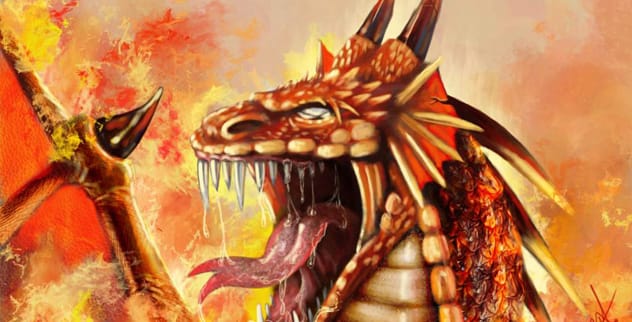Mythical creatures have captivated our imaginations for centuries, starring in ancient legends and modern blockbusters. We think we know them well – the fire-breathing dragon, the wish-granting genie, the graceful unicorn. But beneath the surface of these familiar tales lie fascinating details and surprising truths. Are you ready to journey beyond the well-trodden paths of mythology? Let’s explore 10 astounding facts about these legendary beings that you probably haven’t heard before!
10. Leprechauns: A Protected Species
You probably picture a leprechaun as a tiny, bearded fellow in green, guarding a pot of gold at a rainbow’s end. These solitary shoemakers are famous in Irish folklore for their trickery. While Ireland is their traditional homeland, did you know there’s an official leprechaun colony in Portland, Oregon?
It all began in 1948. Columnist Dick Fagan decided to beautify a tiny, forgotten concrete median that once held a lamppost. He planted flowers and named it Mill Ends, after his column. To spread the word about his unofficial ‘park,’ Fagan humorously claimed he’d seen a leprechaun there, caught it, and wished for a new park. The leprechaun supposedly granted him the very spot. Mill Ends Park was officially dedicated on St. Patrick’s Day, 1948, and became known as the largest leprechaun colony outside of Ireland.
Even more remarkably, leprechauns received protection under European Union Law in 2009! This law aims to preserve The Sliabh Foy Loop in County Louth for its unique flora, fauna, and, yes, leprechauns. Those who campaigned for this protection claim that only 236 leprechauns are left in Ireland, all residing in the Louth area.
9. Household Defenses Against Fairies
Fairies, a diverse group that includes leprechauns, first fluttered into English folklore long ago. One of the earliest accounts comes from Gervase of Tilbury, a 13th-century English scholar. He described fairies as both benevolent and malevolent. In Ireland, the fear of mischievous or evil fairies was once so strong that people avoided even saying their names.
Folks took practical steps to coexist with these magical beings. Some built their homes with front and back doors aligned, leaving them open at night to allow fairies to pass through unobstructed. It’s believed fairies live in a parallel world called the ‘realm of the fey’ and often hide from humans, whom they see as invaders of their land.
If you’re worried about fairies snatching your shiny possessions—they’re said to adore sparkly things—old tales suggest pouring a circle of salt around your valuables for protection. And if you happen to encounter a fairy unexpectedly at night? The traditional advice is to throw breadcrumbs at it and make a quick escape!
8. The Mighty Amarok of Inuit Legend
In the rich tapestry of Inuit mythology prowls the Amarok, a colossal wolf. Legend says this giant creature preys on anyone foolish enough to hunt alone in the darkness of night. Many stories feature the Amarok, including a powerful tale about a young boy seeking greater physical strength.
The boy called out to the lord of strength for help. Suddenly, an Amarok appeared and struck him to the ground with its massive tail. As the boy fell, small bones scattered around him. He was stunned to realize these bones had come from his own body. The Amarok explained that these tiny bones had been stunting his growth. It ordered the boy to return daily to learn how to fight. After several days of this unusual training, the boy gained enough strength to overpower three large bears.
The Inuit people hold the wolf in high regard, viewing its hunting prowess as a benefit to their own quest for food. They also believe wolves play a vital role in maintaining healthy populations of big game animals. To bless their children with a hunter’s skill, some Inuit families would place an anklet made from a wolf’s feet and leg muscles around an infant’s ankle. This was thought to grant the child the speed and endurance of a wolf when they grew old enough to hunt.
7. Mermaid Tears and Ancient Origins
The image of a mermaid – half human, half fish – is iconic, but did you know they were first imagined as half woman, half bird? The transformation to a fish tail is said to have occurred after a legendary dispute with the Muses. Remarkably, depictions of mermaids date back to the Stone Age, around 30,000 years ago!
Over time, mermaids became linked with bad luck and even death, particularly for sailors navigating the vast oceans. To guard against such dangers, seafarers would often carry an aquamarine gemstone. It was believed that aquamarine crystals were formed from the tears of mermaids and offered protection during long voyages.
One of the earliest mermaid legends comes from ancient Syria, centering on the fertility goddess Atargatis. Often shown in mermaid form, Atargatis is considered by many scholars to be the ‘original’ mermaid. By medieval times, numerous accounts of mermaid sightings led many people to accept their existence as a simple fact of life.
6. The Phoenix’s Fiery Superpowers
The majestic phoenix, a creature of flame and rebirth, holds a unique place in mythology. Legend says that only one phoenix exists at any given time, living for a remarkable 500 years. As its life neared its end, the phoenix would build a special nest and engulf itself in fire. From those ashes, a new phoenix would miraculously arise, ready to live another long life.
Ancient Greeks and Egyptians saw the phoenix as a powerful symbol of the sun. One myth even tells of Apollo, the sun god, pausing his chariot and the sun itself to listen to the phoenix’s beautiful dawn song. The bird also represents renewal and rebirth. Because it was said to have once lived in Paradise, it was believed to never truly die.
Beyond its regenerative abilities, the phoenix was thought to possess extraordinary powers. These included an incinerating touch capable of turning a human to ashes in seconds! It was also supernaturally fast, incredibly strong, and could teleport and shapeshift. Some believers still think a single phoenix inhabits the Earth today, forever cycling through death and fiery rebirth.
5. A Modern Tale of the Jinn’s Protection
Jinn, also known as djinn or genies, are powerful supernatural beings from Islamic mythology. These spirits are said to be fashioned from smokeless fire and air, possessing the remarkable ability to shapeshift. They are often described as dual-dimensional, capable of existing in both our visible world and an unseen realm.
While many think of Jinn as wish-granting entities like the famous genie in Disney’s Aladdin, their nature is far more complex. They can also serve as protectors. A striking modern story illustrates this: a girl at a boarding school was being relentlessly bullied. During one confrontation, her bully ripped a chain from her neck.
Instantly, the bullied girl began to speak in a deep, male voice, her body contorting strangely. At the same moment, the bully’s tongue swelled alarmingly, making it hard for her to breathe. The frightening episode only ended when teachers rushed to the scene, at which point everything returned to normal. Later, it was discovered that the bullied girl’s parents had obtained the chain from a shaman; it supposedly contained a protective jinn.
4. The Banshee’s Persistent Wail of Warning
From the misty glens of Irish folklore comes the chilling figure of the banshee, another type of fairy. Her piercing scream is widely considered an unmistakable omen of impending death. Some traditions even suggest that every prominent family in Ireland has its own personal banshee, a spectral harbinger tied to their lineage.
Banshees are said to manifest in various forms: sometimes as a headless woman carrying a bowl of blood, other times as an old woman with her face hidden by a veil. If she becomes aware that someone is watching her, she reportedly vanishes into a cloud of mist. Some banshees are believed to be particularly vengeful spirits, perhaps hating their families during their mortal lives. Their mournful cries might then be interpreted as celebrating the imminent death of a family member they despised, making them among Ireland’s most feared supernatural creatures.
Belief in banshees remains surprisingly strong even today. In 2018, Willy Good from Cork, Ireland, shared a harrowing account. Years earlier, he heard a terrifying howl. He initially dismissed it as prowling cats, but the eerie noise seemed to move around the walls of his house. No cats were found. The wailing continued for about 45 minutes and then abruptly ceased. The next morning, Willy received the tragic news that his nearby neighbors—a father and daughter—had both passed away during the night. He became convinced that more than one banshee had visited his home, heralding the tragedy.
3. How a Unicorn Halted an Army
The unicorn, with its gleaming white coat and signature spiraled horn, is one of the world’s most cherished mythical creatures. Often depicted with a rainbow-hued mane, it’s believed to possess wondrous magical abilities. For many ancient cultures, the unicorn wasn’t just a fantasy; it was described as a real animal and even appeared in early natural history books.
Since the early days of the Christian Church, the unicorn has also been adopted as a powerful symbol of Christ and His unconquerable strength. But one of the most fascinating tales about unicorns involves a pivotal moment in history: a unicorn is said to have influenced Genghis Khan’s decision not to conquer India.
As the story goes, Khan was leading his formidable army towards India. Suddenly, a unicorn appeared before them. The creature then bowed deeply to Genghis Khan. The great leader interpreted this extraordinary event as a divine message from his deceased father, prompting him to halt his advance and turn his army back from the brink of invasion.
2. The Boogeyman’s Surprisingly Grim Origins
The boogeyman, or bogeyman, is a creature of childhood nightmares, but where did this shadowy figure come from? While some tales trace its origins to Scotland, the legend is so widespread across cultures that pinpointing a single source is nearly impossible. The most common image is of a monster lurking under a child’s bed or in a dark closet.
This terrifying figure takes on different forms depending on local folklore. In England, it might be a shadowy ghost. In Germany, it’s often a goblin. Russian children might fear Baba Yaga, while in Mexico, the story of La Llorona serves a similar cautionary role. Each version embodies a local fear designed to scare children into good behavior.
One intriguing theory from the UK suggests a very grim origin for the name ‘boogeyman.’ It’s believed it might have started as a nickname for the ‘buggy men.’ These were the individuals tasked with the somber job of collecting the dead during the terrifying Black Plague. Due to their constant contact with deceased plague victims, these men often contracted the disease themselves, becoming gaunt, pale, and frightening in appearance. It’s thought that their chilling looks are what eventually led to them being called ‘boogeymen,’ a name that has haunted imaginations ever since.
1. The Enduring Mystery of Dragons
Dragons, those magnificent, fire-breathing behemoths, are staples of fantasy and folklore. Much like the boogeyman, it’s difficult to say exactly where or when the first dragon legends took flight. What we do know is that these powerful creatures were being described as far back as the time of the ancient Greeks.
For many centuries, people around the world would occasionally unearth massive, unfamiliar fossils. Without the scientific understanding we have today about dinosaurs, many cultures connected these giant bones to dragons. Soon, dragons were often cast as formidable villains, creatures of immense power that brave heroes had to slay. The Christian church, in its early days, even equated dragons with Satan, and a dragon’s fiery maw was sometimes depicted as the very entrance to hell.
A striking tale from medieval folklore features St. Margaret of Antioch. Imprisoned for her Christian beliefs, legend says a fearsome dragon lurked in her cell. As she entered, the dragon swallowed her whole. However, divine intervention granted St. Margaret the power to burst forth from the dragon’s stomach, leading to her survival and the creature’s demise. In a perhaps unexpected turn, St. Margaret later became the patron saint of childbirth, a symbol of overcoming dire circumstances.
These glimpses into the lesser-known aspects of mythical creatures show us that there’s always more to discover. Behind every legend, there’s a rich history, surprising details, and often, a very human attempt to explain the unexplainable or pass down important cultural values. The world of mythology is a vast and ever-surprising place, proving that these ancient beings still have much to teach us.
Which of these mythical creature facts surprised you the most? Do you know any other obscure legends? Share your thoughts and favorite tales in the comments below!










